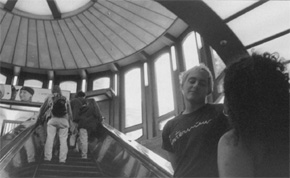 |
 |
 |
 |
|
Retinal Degenerative Diseases

The retina is a specialized light-sensitive tissue at the back of the eye that contains photoreceptor cells (rods and cones) and neurons connected to a neural network for the processing of visual information. The rods function in conditions of low illumination whereas cones are responsible for color vision and all visual tasks that require high resolution (e.g. reading). The rods are mostly located away from the center of the eye in the retinal periphery. The highest concentration of cones is found at the center of the retina, the macula, which is necessary for visual acuity. For support of its metabolic functions, the retina is dependent on cells of the adjacent retinal pigment epithelium.

|
Retinitis pigmentosa (RP) designates a group of inherited diseases that affect the retina and are characterized by a gradual destruction of the rods and cones, resulting in a progressive loss of vision and, possibly, blindness. Usually, the rod cells are the first to degenerate, causing night blindness (fig. 1a) and 'tunnel vision' (fig. 1b). RP is most often diagnosed during childhood or early adulthood. Depending on the type of RP, the rate of progression varies. To date, there is no known way to halt the degeneration of the retina or to cure the disease.
|
|
Pass cursor over image to view night blidness


Fig. 1a
Night blindness
Pass cursor over image to view 'tunnel vision'


Fig. 1b
Loss of peripheral vision ('tunnel vision') in RP. In some cases small patches of retinal activity on the peripheral are preserved, making it possible to detect movement and objects that help improve orientation.
|
|
|
Macular degeneration refers to a group of disorders in which the breakdown of cells is limited to the macula, leading to a loss of central vision (fig. 2). The most common form, age-related macular degeneration (AMD), usually affects people over the age of 60. There are two types of AMD: 'dry' and 'wet'. Dry AMD accounts for about 90% of all cases. With dry AMD, yellow-white deposits called drusen accumulate in the retinal pigment epithelium tissue beneath the macula. In wet AMD, abnormal blood vessel growth forms beneath the macula. These vessels leak blood and fluid into the macula damaging photoreceptor cells. In some cases, if wet AMD is diagnosed early, laser surgery has been shown to reduce the risk of extensive macular scarring. Hereditary forms of macular degeneration with an early onset, such as Stargardt disease, Best's disease or progressive cone dystrophy, also exist. As a general rule these diseases cause severe visual impairment but rarely result in complete blindness.
For the vast majority of MD patients there is currently no effective treatment, but a number of effective visual aids and rehabilitation options are available.

Individuals with Usher syndrome suffer from RP and congenital deafness or progressive hearing loss.
|
|
Pass cursor over image to view loss of central vision


Fig. 2
Loss of central vision in macular degeneration. Affected individuals have difficulty reading and recognizing faces, but enough peripheral vision is retained for good orientation and mobility.
|
|

Close window
|
|
|
 |


